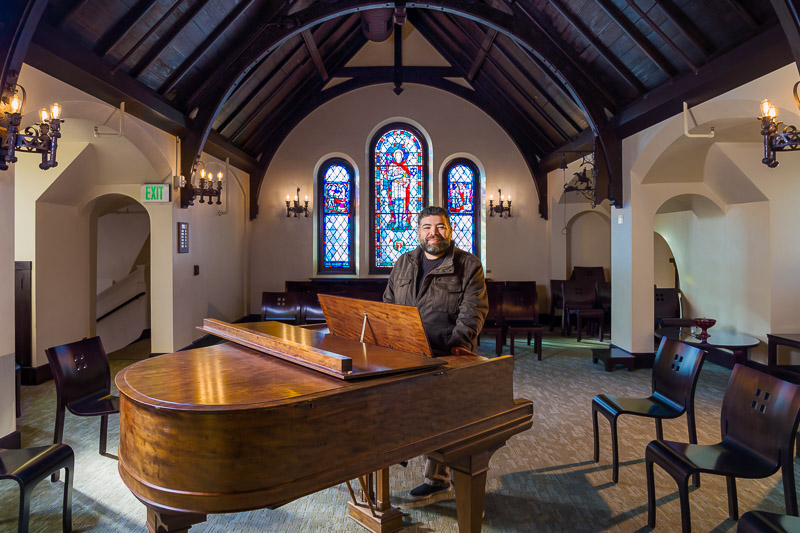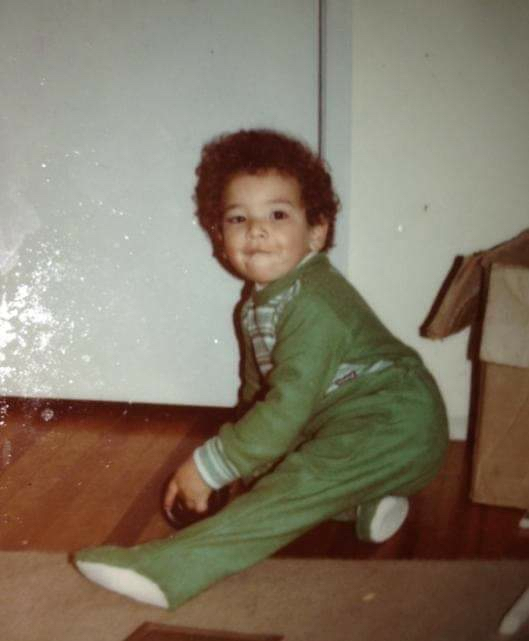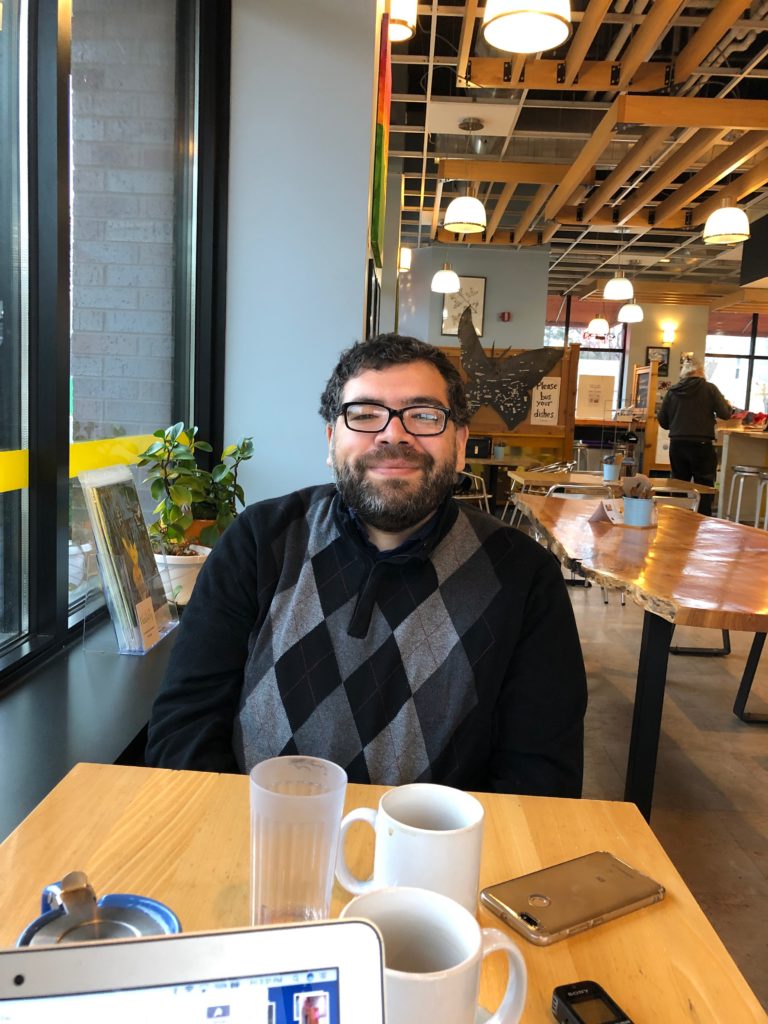When I came to Minneapolis and started organizing a choral group that served Latinx audiences, I went to the Chicano and Latino Studies Department at the U of MN to drum up some interest. As soon as they saw my name they were like, “Oh My God, an Anzaldua!”
Growing up, Gloria Anzaldúa was my weird aunt from the other side of the border who, smoked cigars, had a big car, and cursed. I didn’t realize she was a mother of Chicana Studies until I went to college and read her books. By then she had already passed.
—Ahmed Anzaldua

The Anzalduas came to Mexico from Spain in the 1700s and settled in the Rio Grande Valley. In the 1850s after the U.S. Mexico War, some of the Anzalduas ended up on the US side of the border and others in Mexico. Gloria Anzaldúa grew up in Texas. I really admire her work. Her thoughts about crossing and blurring cultural borders inspired Border CrosSing.
My life is full of border crossings. My mom was from Egypt, my father from Mexico. They met when they were in college. I grew up in Northern Mexico in the only Muslim household for hundreds of miles.

My mom passed when I was ten and my Dad when I was fourteen. My brother and I moved in with my grandparents. They were a Catholic household. They did their best to keep us Muslim, but it didn’t take. I formerly converted to Catholicism so I could marry my wife without drama, but I am not particularly religious.
I grew up playing trumpet. At sixteen I started playing piano in little bars and with local bands, but I didn’t think I was good enough to be a professional musician, so I went to medical school. That lasted a year, until I met my wife, who was a violinist, and I won a piano competition that opened doors to study music in Spain. I continued my studies at Western Michigan University.
At Michigan they had me work with the choir and I fell in love with choral music. I came to the University of Minnesota for my doctorate because I knew Minneapolis was a hotbed of choral music.
Border CrosSing
When I came to the Twin Cities I found no groups playing Latin American choral music. I’d go to concerts, be the only Mexican there, and come home with all these ideas for programs and projects that invite more diverse audiences. Those ideas became Border CrosSing.
Our first concert was in September 2017, at Our Lady of Guadalupe Church. There were many unknowns. We weren’t sure it was going to happen. We weren’t sure people would come. We didn’t know how people would receive it.
We had a big crowd, but more importantly, it was the sort of crowd I remember seeing in Mexico. It wasn’t a room full of White people over 65. It was a mix of younger and older people, Latinxs and other people, all in the same room. Some people were appreciating it for the connection it had to their culture, others for the entertainment value.
Border CrosSings has grown very fast. I started applying for grant support and looking for donations, calling in favors from musician friends. I don’t ask people to do things for free. Everything is done in a way that is sustainable. We are in the middle of our second year and planning our third year of concerts, community singing events and song circles.
We work with other choirs. The choral music world is very small. We know each other and we collaborate in many ways. My mentor at the U of M is head of the Minnesota Chorale, an organization that has been a great source of support for our work. We collaborate with other Latinx artists like Alma Andina, an ensemble that has been playing in Twins Cities for 15 -20 years.
I think the fact that Latin American music is misrepresented or not represented in a city as inclusive as this, tells you a lot about the stereotypes people have about Latin American people. At every concert we do, one of my goals is to help people learn something about Latin American culture they did not know. Or find a point of connection. Or–for someone who is from Latin America–to see something in themselves that they weren’t aware of before. The music is great, emotional and moving, but ultimately, it is about the story that the programming tells.
The focus is still on Latin American music but the mission is broad enough to incorporate other traditions in the future. The root problem for me wasn’t that Latin America wasn’t represented, but that the music was overwhelmingly that of the European Lutheran classical western tradition. There are so many other choral traditions, venues, audiences and presentations.
Last year we did a bilingual version of Handel’s Messiah. There is a misconception that this kind of music is not for Latin Americans; that it will fly over our heads; that we won’t understand; that we get mariachi, but we won’t get Mozart.
We paired Handel with music from Mexico composed at the same time period. We performed it at Our Lady of Guadalupe Church. That Catholic Church has been in St. Paul since 1931, yet the Messiah had never been performed there.
I looked out at the audience. In the back, on one of the church pews, was an entire family sitting there, mom, dad, four kids, enjoying the concert so much, passing around a big bag of cheese puffs. They sat through the entire concert, even with little kids.
My first impulse was to tell them, “You don’t do that at a concert,” but then I realized, it was so nice to be able to present a two-hour work of classical music, that a whole family could come to and stay, enjoying a snack and the music. It made my day. When I go to most classical music concerts, I often wonder, what is the audience thinking? Sometimes they sit there with a blank face and I wonder if they are there because they feel like they have to get some culture. Seeing those people, including noisy babies, genuinely enjoying music for what it is… I love those moments.
I can’t imagine being able to do this project anywhere else. The nonprofit system in Minnesota, the support for the arts, and the collaboration among choral groups has made it possible.
Justice Choir
The 2016 election prompted a lot of people to take on justice projects. My friends Abbie Betinis and Tesfa Wondemagegnehu are well-known in the Twin Cities choral music world. Abbie wanted to write a song book that would provide people with protest songs to sing. A few weeks into the process they brought me in. I began to help with the songs people were writing. Eventually we published a volume with 43 songs.
That song book took a lot of work. There were many deadlines that we missed. Many nights working until 6AM. We wanted to make it accessible to people. People would send us songs on their cell phones. There was a lot of engraving, transcribing, writing out notes, laying out text so others could sing it and adapt it for their needs. We got 150 submissions. A lot of them we worked on and then ended up discarding. Everyone’s song must be free to use.
Justice Choir sings at vigils and protests. There are now fourteen Justice Choir chapters around the world. Composers keep sending us new songs. It is a living thing. We published that first book August, 2017. I occasionally lead sings, and get called to answer emails, but now it is essentially Abbie’s project. I assist when I can.
My background is as a classical pianist and conductor. That typically involves standing in a concert hall or a church. Justice Choir events have gotten me leading songs in bars, pubs and protests like the International Workers Day March last year. I found myself playing pop music — a situation I would never have been in if I was just focusing on classical. I’ve appreciated that. It has given me new tools and experience and forced me to find ways to connect those two worlds.

Being a Justice Musician Involves More than Music
There is a lot of logistical work that goes into creating music when you are not big enough to have a crew. After a concert you are exhausted, but you have to stay for two hours to take down the chairs and clean up. It is the artistic director who throws out the trash. One of our soloists with a big beautiful opera voice, also drives a truck and takes down the risers and music stands.
When you are in charge of everything, there are mistakes. For a Community Sing event we had a small budget to print posters. We had a lovely design. We printed 300 copies of a beautiful poster before anyone realized something was missing. I had to take a white marker and write in the date and time on each poster.
My Future is Uncertain, Circumscribed by Immigration
In an ideal world I would finish my degree and do Border CrosSing full-time, but I am tied to the requirements of the immigration system. In order to stay in the country I must acquire a teaching and performing job that fits their professional definition and specifications. Border CrosSing is not big enough. So I am applying for teaching and performing jobs and I will go where they take me. I am setting things up with Border CrosSing so that someone can take care of the day-to-day and it can continue.
One of the hot topics for big performing organizations like the Minnesota Orchestra or Minnesota Chorale is, “How do we connect with underrepresented communities in classical music?” Sometimes they sincerely want to get their art out there. Sometimes foundations or grants are requiring it. What we’ve done with Border CrosSing is create a model and guidelines for art organizations for a genuine, relevant, sustainable presence in a community. That is the focus of my thesis: documenting our experience, establishing those principles.
I know we are making a difference.
I look at other programs and see that they are performing music no one had done in the Twin Cities before us. Our collaborators are getting invitations to participate in concerts with major arts organizations. Some high-profile institutions are considering using one of our performing spaces in the community.
We are affecting how art organizations function. That, in turn, affects how people think, feel, vote, spend, act.
Update, November 2019: Fortunately for the Twin Cities, Ahmed is still here, directing music at Unity Church, collaborating with the Minnesota Orchestra, transforming our musical landscape. The Justice Choir sang outside the Target center when Trump was in town, October 10, 2019. Latest activities of BordercrosSing.
On the Minneapolis Uprising and Murder of George Floyd
I’ve spent a lot of time this week with my Latinx communities here in the Twin Cities. There is real pain and anger in our communities, both in reaction to the tragic killing of George Floyd and to the widespread destruction of our neighborhoods.
Racism is also present in the Latinx community, and it has always been difficult to root it out; Latinxs come in all shades and colors and are also the victims of injustice, persecution, police brutality, mass detention, and mass deportation in the United States. However, even in the midst of our present pain and anger, I am seeing something different, something I had not seen before. I am seeing young Latinxs calling out their elders on racist remarks. I am seeing a renewed solidarity between Latinx and Black communities. I am seeing Latinx business owners who would normally not hesitate to call the police on a Black person call for the disbandment of the police.
I saw Cadex Herrera, Pablo Helm-Hernandez, and Xena Goldman, three young Latinx artists, rush to the corner of Chicago and 38th St. to paint the now emblematic mural that marks the site of George Floyd’s killing. We are finally starting to wake up to the fact that turning on each other has only served to keep us all down. The brutal reality of the video of George Floyd and the explosion of grief that followed it laid bare for most of us that, in the white gaze, we are all Black, that the only right thing to do, the one thing we must do to ensure our own survival, is to start acting like it. We are all Black now.
Although this last week my life’s been mainly about raising money, helping clean, and deliver groceries, I am a musician, and I need music to make sense of the world. I used social media to share “St. Martin of Porres” by Mary Lou Williams from a concert Border CrosSing performed last year at Church of the Ascension in north Minneapolis.
“St. Martin of Porres” is the first track of Mary Lou Williams’ album “Black Christ of the Andes” and is a hymn dedicated to a Black saint from Peru, canonized in 1962, a saint that is venerated all throughout Latin America as a miraculous healer and regarded as the patron saint of all those that seek racial healing. Mary Lou recognized that we live in a broken system and saw herself as a healer; she believed firmly in music’s capacity to heal the soul and how necessary that individual healing is for our society to heal.
Minneapolis Interview Project Explained

